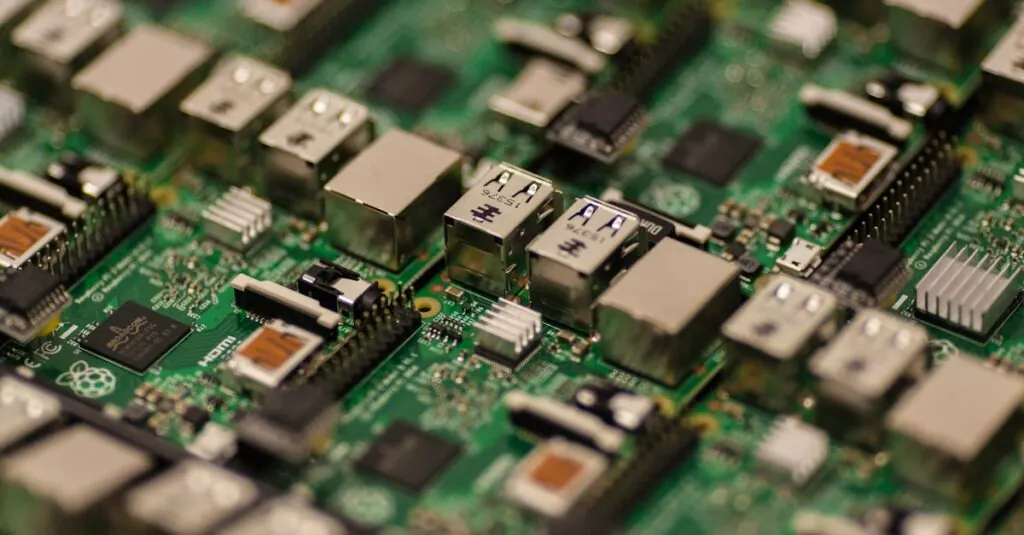Table of Contents
ToggleChoosing the right monitor cable can feel like navigating a maze of confusing options. With so many types out there, it’s easy to get tangled up in the details. But fear not! Understanding monitor cable types is key to achieving that crystal-clear display you’ve been dreaming of.
Overview of Monitor Cable Types
Understanding monitor cable types is crucial for achieving high-quality display output. Several cable types exist, each serving specific purposes and providing unique connectivity options.
HDMI (High-Definition Multimedia Interface) connects displays to multiple devices. It supports both audio and video signals, making it ideal for televisions, projectors, and monitors. Its versatility allows for resolutions up to 4K.
DisplayPort offers a robust alternative to HDMI. This cable type handles high resolutions and refresh rates, making it a favorite among gamers and professionals. With features like daisy chaining, DisplayPort connects multiple monitors through a single port.
VGA (Video Graphics Array) remains relevant despite being an older technology. VGA cables transmit analog signals and work best with older monitors and projectors. While it doesn’t support high resolutions, it provides compatibility for legacy devices.
DVI (Digital Visual Interface) bridges the gap between analog and digital signals. This cable type comes in several variants, including DVI-D (digital only) and DVI-I (integrated, for both digital and analog). DVI is commonly used with computer monitors and projectors.
USB-C has emerged as a modern standard for video output. Many newer devices support USB-C, allowing for easy connection without additional adapters. Its ability to charge devices while transmitting video adds to its appeal.
Thunderbolt integrates with USB-C technology, delivering high data transfer rates. Ideal for professionals using high-resolution displays, Thunderbolt supports daisy chaining multiple devices.
Selecting the appropriate monitor cable depends on the devices used and the required display quality. Knowing the capabilities of each cable type simplifies the decision-making process and enhances user experience.
Common Monitor Cable Types
Understanding common monitor cable types helps optimize display performance. Each cable type serves specific functions and supports various resolutions.
HDMI Cables
HDMI cables connect monitors to devices like computers, gaming consoles, and Blu-ray players. These cables support audio and video signals in a single cable, enhancing convenience. Categories like Standard, High Speed, and Ultra High Speed exist, with Ultra High Speed supporting resolutions up to 8K. Users find HDMI an ideal choice for most modern setups due to its universal compatibility.
DisplayPort Cables
DisplayPort cables cater to high-end gaming and professional monitors. These connectors support high resolutions and refresh rates, accommodating multiple displays from one source. Features like Adaptive Sync reduce screen tearing, contributing to a smoother gaming experience. Versions 1.4 and 2.0 support resolutions from 4K to 16K, making DisplayPort a top choice for enthusiasts.
VGA Cables
VGA cables offer an analog connection, primarily used with legacy devices. Despite being outdated, many older projectors and monitors still utilize this technology. Maximum supported resolution typically caps at 1080p, restricting compatibility with modern displays. Users may require adapters to connect VGA to newer systems, illustrating its gradual phase-out.
DVI Cables
DVI cables deliver a bridge between analog and digital signals. With various configurations like DVI-I and DVI-D, they cater to different needs. DVI supports resolutions up to 2560×1600 for digital displays and 1920×1200 for analog. Though primarily replaced by HDMI and DisplayPort, DVI remains suitable for specific setups.
Specialized Monitor Cable Types
Various specialized monitor cable types enhance connectivity and performance. Understanding each type aids in selecting the best option for specific needs.
USB-C Cables
USB-C cables serve as a modern solution for video and data transmission. These cables support resolutions exceeding 4K, making them suitable for high-definition displays. Furthermore, USB-C cables provide power delivery, allowing devices to charge while connected. Using USB-C simplifies connections due to its reversible design. Different laptops, tablets, and monitors now incorporate this versatile cable type, ensuring widespread compatibility across several devices.
Mini DisplayPort Cables
Mini DisplayPort cables present a compact alternative for connecting monitors. This cable type supports high resolutions up to 4K and offers superior refresh rates, benefiting multimedia experiences. Many laptops and professional devices use Mini DisplayPort, appealing to graphic designers and gamers. Compatibility with Thunderbolt provides additional versatility, enabling high-speed data transfer between devices. Mini DisplayPort cables deliver high-quality audio and video signals, ensuring optimal performance across various displays.
Selecting the Right Monitor Cable
Selecting the right monitor cable involves understanding key factors that determine compatibility and performance.
Compatibility Considerations
Compatibility between the monitor and the device dictates the choice of cable. HDMI works with most modern devices, making it a popular option for general use. DisplayPort excels for gaming setups due to its support for higher refresh rates and multiple displays. VGA cables suit older devices, while DVI can bridge connections between modern graphics cards and older monitors. USB-C offers versatility, especially for newer laptops and monitors, thanks to its reversible design. Thunderbolt provides enhanced capabilities but requires matching hardware to fully utilize its features, so checking device specifications remains crucial.
Performance Factors
Performance plays a significant role in the cable selection process. HDMI supports high resolutions, with Ultra High Speed versions enabling 8K output. DisplayPort maintains higher refresh rates, essential for gamers seeking smooth gameplay. VGA typically caps at 1080p, limiting it in clarity compared to newer standards. DVI provides better quality than VGA, reaching resolutions of 2560×1600. USB-C supports high-definition displays and power delivery, streamlining connections. Understanding these performance factors helps ensure the cable meets specific requirements for both visual quality and device functionality.
Conclusion
Selecting the right monitor cable is crucial for achieving optimal display performance. With various options available each catering to different needs understanding the differences can significantly enhance the user experience. Whether it’s the versatility of HDMI the gaming prowess of DisplayPort or the simplicity of USB-C knowing the right cable for the task ensures compatibility and performance. By considering the specific requirements of devices and displays users can make informed choices that elevate their visual experience. As technology continues to evolve staying updated on cable types and their capabilities will remain essential for anyone looking to maximize their setup.




